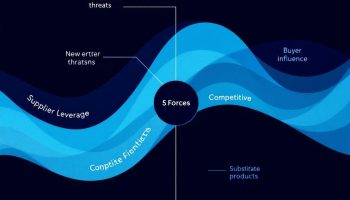
Transforming Insights with Big Data Predictive Analytics
Big data predictive analytics transforms how organizations extract useful insights from massive, complex datasets. By using advanced algorithms and statistical methods, businesses can forecast future events, identify hidden patterns, and make data-driven decisions significantly faster than competitors.
Key Takeaways:
- Big data predictive analytics combines massive data volumes with advanced statistical techniques to generate strategic business insights.
- Companies implementing these solutions can achieve significant operational efficiency improvements of up to 30%.
- Machine learning, artificial intelligence, and cloud computing are core technologies powering predictive analytics capabilities.
- Applications span multiple industries, including retail, finance, healthcare, and transportation.
- Successful implementation requires robust data processing infrastructure and a structured approach to model development.
Modern predictive analytics tools enable you to process information from diverse sources simultaneously, creating a comprehensive view of operations, customer behavior, and market trends. This integration allows for more accurate forecasting and better decision-making across your organization.
The technology has evolved dramatically with advancements in computing power. What once required specialized data centers can now run on cloud platforms, making these capabilities accessible to organizations of all sizes. Companies that adopt data-driven decision processes gain substantial competitive advantages in customer acquisition, retention, and overall market positioning.
Implementation challenges often involve data quality issues and the need for specialized talent. However, the introduction of user-friendly platforms has simplified adoption considerably. Your organization can start with focused projects addressing specific business problems before expanding to enterprise-wide applications.
The future of big data analytics includes increasing automation and machine learning integration, allowing systems to continuously improve prediction accuracy with minimal human intervention. This technology continues to drive innovation across industries, from personalized medicine to supply chain optimization.
“Big data predictive analytics revolutionizes decision-making by transforming vast, intricate datasets into powerful insights, enabling organizations to forecast future trends and reveal hidden patterns at unprecedented speeds. By harnessing advanced algorithms and machine learning, businesses can not only outpace competitors but also achieve operational efficiencies that redefine industry standards.”
Understanding Big Data and Predictive Analytics
Big data predictive analytics combines two powerful technologies that are transforming how businesses operate. Big data refers to massive volumes of structured and unstructured information gathered from diverse sources including sensors, transactional systems, social media, and IoT devices. This data explosion has created unprecedented opportunities for organizations to extract valuable insights and predict future outcomes.
Predictive analytics uses historical data to forecast future events or behaviors through sophisticated algorithms and statistical methods. By leveraging big data predictive analytics, you’ll gain the ability to identify patterns, trends, and relationships that would otherwise remain hidden in your information assets. Companies implementing these solutions make decisions 2.5 times faster than their competitors, creating substantial market advantages.
Core Technologies Powering Big Data Predictive Analytics
The foundation of big data predictive analytics rests on several key technologies working in concert:
- Machine learning algorithms that improve with experience
- Artificial intelligence systems that mimic human decision-making
- Statistical models including regression analysis and decision trees
- Cloud computing platforms that provide scalable processing power
- Data visualization tools that make complex insights accessible
You’ll find big data predictive analytics applications across numerous industries. In retail, Walmart uses these techniques for demand forecasting by analyzing sales and weather patterns. Financial institutions apply big data predictive analytics for fraud detection and credit risk assessment, with JPMorgan Chase reporting their AI tools improved client service by 95%.
The implementation of big data predictive analytics requires a structured delivery framework to ensure success. You’ll need to establish clear processes for data acquisition, preprocessing, model development, and deployment. This methodical approach helps avoid common pitfalls and ensures your big data predictive analytics initiatives deliver meaningful business value.
When planning your big data predictive analytics strategy, consider database analytics solutions that can efficiently process large information volumes. The right infrastructure enables you to handle the computational demands of predictive modeling while maintaining performance and reliability.

Operational Mechanics of Predictive Analytics
From Data to Decisions: The Big Data Predictive Analytics Workflow
Big data predictive analytics follows a systematic workflow that transforms raw information into actionable business intelligence. This process begins with a clear problem definition – identifying exactly what you need to predict and why it matters to your organization. Your success with big data predictive analytics depends on this foundational step.
The workflow continues through these critical phases:
- Data acquisition and organization – collecting and structuring data from various sources
- Data preprocessing – cleaning, normalizing, and preparing data for analysis
- Model development – creating statistical and machine learning algorithms
- Validation and deployment – testing accuracy and implementing in production environments
Effective big data predictive analytics requires robust data processing infrastructure. You’ll need scalable compute resources to handle massive datasets and high-speed networking to move data efficiently. These technical foundations enable the database analytics processes that form the backbone of predictive capabilities.
The platforms supporting big data predictive analytics typically include:
- Enterprise data warehouses
- Cloud computing solutions
- Distributed processing frameworks
- Specialized analytics software
Your big data predictive analytics implementation will likely utilize multiple technologies working in concert. Modern project implementation often combines on-premises systems with cloud services to achieve optimal performance and flexibility.
The table below summarizes the essential components of big data predictive analytics infrastructure:
| Component | Function | Example Technologies |
|---|---|---|
| Storage | Houses structured and unstructured data | Hadoop, AWS S3, Google Cloud Storage |
| Compute | Processes analytical workloads | Apache Spark, AWS EMR, Azure Databricks |
| Modeling | Creates predictive algorithms | Python, R, TensorFlow, PyTorch |
| Visualization | Presents insights to users | Tableau, Power BI, D3.js |
Big data predictive analytics continues to evolve rapidly. Your ability to integrate these technologies and establish effective continuous improvement processes will determine how much value you extract from your data assets.

Real-World Applications and Case Studies
Big data predictive analytics transforms how companies operate across various industries. You’ll find compelling evidence of its impact through several high-profile implementations that demonstrate the power of data-driven forecasting.
Walmart has revolutionized its inventory management using big data predictive analytics to forecast demand patterns. By analyzing sales history alongside weather data, they’ve optimized stock levels and reduced waste. This application of big data predictive analytics has resulted in significant cost savings and improved customer satisfaction through better product availability.
Netflix exemplifies how big data predictive analytics drives personalization at scale. Their recommendation engine processes viewing habits of millions of subscribers to suggest content that matches individual preferences. Using cloud services to manage this massive data processing, Netflix has created a competitive advantage through advanced database analytics that keeps viewers engaged.
Uber represents one of the most data-intensive applications of predictive analytics, processing over 100 petabytes of data daily. Their algorithms optimize driver positioning, predict surge pricing needs, and estimate arrival times. These big data predictive analytics capabilities form the backbone of their operational efficiency.
Financial Industry Applications
Financial institutions leverage big data predictive analytics for critical functions:
- Fraud detection systems that analyze transaction patterns in real-time
- Credit risk assessment models that evaluate borrower behavior
- Customer segmentation for targeted product offerings
- Trading algorithms that predict market movements
JPMorgan Chase demonstrates the transformative potential of big data predictive analytics with AI tools that have improved client service efficiency by 95%. This implementation shows how strategic project management can successfully deploy advanced analytics solutions that deliver measurable results.
| Industry | Primary Applications | Benefits |
|---|---|---|
| Retail | Demand forecasting, Inventory optimization | Reduced waste, Improved stock levels |
| Entertainment | Content recommendations, User engagement | Increased viewing time, Lower churn |
| Transportation | Dynamic pricing, Route optimization | Higher efficiency, Better utilization |
| Financial | Fraud detection, Risk assessment | Lower losses, Better lending decisions |
| Healthcare | Patient outcome prediction, Resource allocation | Improved care, Cost reduction |
These cases demonstrate how big data predictive analytics creates competitive advantages through enhanced decision-making capabilities and operational insights that weren’t previously possible with traditional analytics approaches.
Expert Insight: To harness the power of big data predictive analytics, organizations should study successful case studies from industry leaders like Walmart, Netflix, and Uber. These examples illustrate how data-driven strategies can optimize operations, enhance customer engagement, and improve financial outcomes. By equipping teams with advanced analytics tools and fostering a data-centric culture, companies can unlock significant competitive advantages and drive impactful results.
Business Outcomes and Strategic Benefits
You’ll achieve remarkable efficiency gains through big data predictive analytics implementation. Organizations typically see operational efficiency improvements up to 30% by optimizing processes and resources based on predictive insights. This translates directly to your bottom line with financial ROI reaching 250-500% in the first year alone when properly executed.
Risk management capabilities transform dramatically with big data predictive analytics at your disposal. Companies report a 60% improvement in fraud detection accuracy, protecting revenue and reputation simultaneously. Your organization can develop effective risk response plans informed by data patterns that human analysts might miss.
Strategic advantages emerge through enhanced decision-making speed and quality. You’ll outpace competitors by:
- Identifying market trends before they become obvious
- Optimizing pricing strategies based on demand forecasting
- Allocating resources more effectively across operations
- Predicting customer behaviors to improve retention
Customer engagement benefits significantly from big data predictive analytics applications. The ability to anticipate needs creates opportunities for personalized experiences that drive loyalty and increased lifetime value. Your engagement strategies become more precise and effective when powered by predictive insights.
| Benefit Area | Typical Impact |
|---|---|
| Operational Efficiency | 20-30% improvement |
| Financial ROI | 250-500% first-year return |
| Risk Reduction | 60% better fraud detection |
| Decision Speed | 2.5x faster than competitors |
| Customer Retention | 15-25% improvement |
Implementation Considerations for Maximum Value
To fully capitalize on big data predictive analytics benefits, you need strategic alignment between technology and business objectives. Start by identifying high-value use cases where data-driven predictions can directly impact key performance indicators. Your implementation approach should focus on quick wins while building toward more sophisticated applications.
Data quality remains fundamental to success with predictive analytics. You’ll need robust processes for validation, cleaning, and integration. Poor data quality undermines even the most advanced big data predictive analytics models, while high-quality data amplifies their effectiveness.
Organizations leveraging predictive analytics have seen a remarkable 20-30% improvement in operational efficiency, directly impacting their bottom line with potential financial returns of 250-500% in the first year.
forbes.com
Future of Predictive Analytics
The big data predictive analytics landscape is evolving rapidly with new innovations constantly reshaping how businesses leverage data for strategic advantage. Market projections show this field growing at an impressive 20.4% CAGR, making it one of the fastest-expanding segments in the technology sector.
This growth is fueled by the increasing integration of artificial intelligence with big data predictive analytics systems. As AI algorithms become more sophisticated, they enable deeper pattern recognition and more accurate forecasting capabilities. You’ll find these advancements particularly valuable when implementing database analytics across your organization’s decision-making processes.
Real-time big data predictive analytics represents the next frontier in business intelligence. Unlike traditional systems that process information in batches, real-time capabilities allow you to make immediate adjustments to operations, marketing strategies, and customer interactions. This shift dramatically reduces the lag between data collection and actionable insights.
Cross-Industry Expansion of Big Data Predictive Analytics
The application scope of big data predictive analytics continues to widen across industries:
- Healthcare: Predictive models now forecast patient readmissions and disease progression with increasing accuracy.
- Manufacturing: Smart factories use big data predictive analytics for equipment maintenance and production optimization.
- Retail: Customer behavior prediction has become more granular, enabling hyper-personalized marketing.
- Finance: Advanced fraud detection systems process transactions in milliseconds to identify suspicious patterns.
These expanding applications demonstrate how big data predictive analytics is becoming central to effective strategic planning in virtually every sector.
Technological advancements in machine learning algorithms and data processing capabilities will continue accelerating the big data predictive analytics revolution. Edge computing developments now allow analysis closer to data sources, reducing latency and enabling faster insights. This proves particularly valuable for organizations implementing continuous improvement methodologies that require constant data-driven refinement.
As these technologies mature, you’ll find big data predictive analytics becoming more accessible, with user-friendly interfaces making powerful forecasting tools available to business users without specialized data science expertise. This democratization of big data predictive analytics will be a key factor in its continued growth and adoption across organizations of all sizes.






